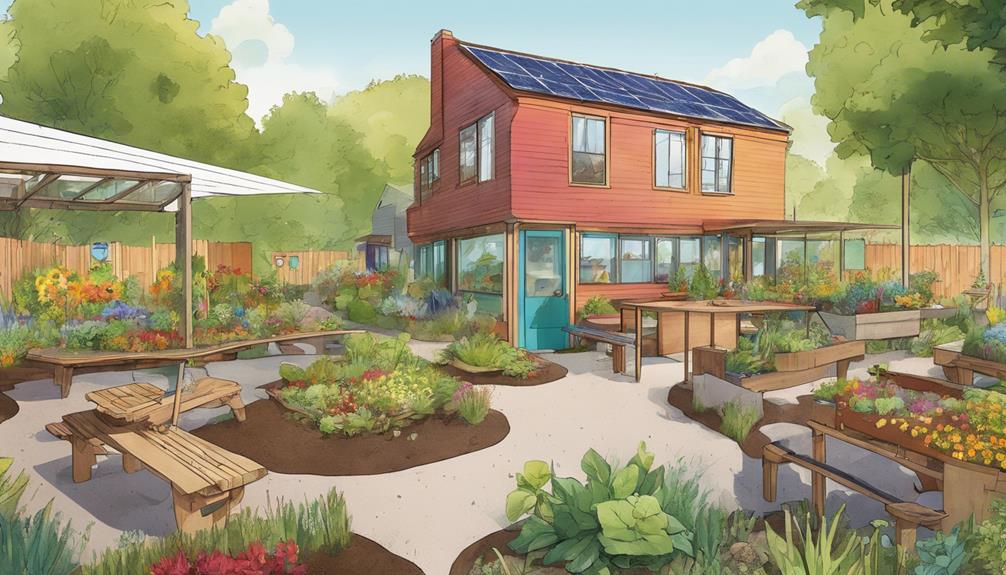To make your new home eco-friendly after the move, start by assessing energy efficiency. Check insulation, window seals, and consider upgrading to ENERGY STAR certified appliances to save energy. Next, prioritize water conservation by fixing leaks and installing low-flow fixtures. Switch to LED light bulbs for significant energy savings and bring in smart technology, like thermostats, to monitor usage. Adopt waste reduction by recycling and composting. For decor, choose sustainable materials and incorporate plants for air quality. Lastly, engage with your community to support local sustainability initiatives. These steps can lead to a greener lifestyle, and there's more to explore.
Assess Your New Space

When you move into a new home, it's crucial to assess your space right away to uncover opportunities for making it more eco-friendly.
Start by evaluating the energy efficiency of your home. Check the insulation quality, window seals, and how well your heating and cooling systems perform.
Responsible recycling of materials can also play a role in creating a sustainable environment. Identifying areas for improvement can lead to a more comfortable and energy-efficient environment.
Next, inspect your current appliances. If they're not energy efficient, consider upgrading to ENERGY STAR certified models, which can use 10-50% less energy compared to standard options. This simple change can significantly lower your energy bills.
Don't forget about water usage. Look for leaks in faucets and toilets, and think about installing low-flow fixtures. These can reduce water consumption by up to 60%, making a big difference in your utility costs.
Analyze how natural light flows through your space, optimizing it for passive solar heating and reducing the need for artificial lighting.
Finally, assess your landscaping. Choosing native plants for your gardens can require less water and maintenance while supporting local ecosystems.
Sustainable Home Setup
Creating a sustainable home setup involves making intentional choices that enhance energy efficiency and reduce waste. Start by installing Energy Star certified appliances, which can save you up to 30% on energy bills compared to standard models.
Additionally, consider using eco-friendly packing materials when moving to minimize waste during your transition. Switching to LED light bulbs is another smart move; they use at least 75% less energy than incandescent bulbs and last up to 25 times longer.
Next, consider implementing a home recycling system. Setting up designated bins for paper, plastic, and compost can help you manage waste effectively, ensuring that at least 50% of your household waste is recycled or composted, thus minimizing landfill contributions.
You might also want to invest in a smart thermostat. This technology optimizes your heating and cooling costs by adjusting temperatures based on your occupancy, potentially reducing costs by 10-30%.
Finally, when painting or finishing your home, choose low-VOC eco-friendly materials to improve indoor air quality, as they emit fewer harmful chemicals. If you're moving, consider hiring a sustainable moving company to help you reduce waste during the transition.
With these steps, you'll create a more eco-friendly home.
Energy-Efficient Appliances

When you upgrade to ENERGY STAR certified appliances, you're not just saving energy; you're also cutting down on your utility bills.
These smart appliances use significantly less energy and water, which means you can save money while helping the environment.
By implementing an eco-friendly approach to your moving budget, you can also allocate funds towards cost-effective moving strategies that minimize waste.
Plus, many of them come with tax credits or rebates that make the switch even more appealing, so you'll feel good about your choices for your home.
ENERGY STAR Certification Benefits
Upgrading to ENERGY STAR certified appliances is a smart choice for any homeowner looking to reduce energy consumption and save money. These energy-efficient appliances use 10-50% less energy than standard models, which means you'll see a noticeable drop in your utility costs.
Additionally, by making sustainable choices like these, you can significantly lower your carbon footprint during a move and contribute to healthier living spaces. Imagine saving $300 or more each year just by making a few eco-friendly changes!
Not only do ENERGY STAR certified appliances help you save money, but they also contribute to reducing greenhouse gas emissions. By choosing these products, you're part of a larger effort that cuts over 130 million metric tons of greenhouse gases annually, equivalent to the emissions of more than 28 million vehicles.
Moreover, these appliances deliver high performance without sacrificing features or comfort. You won't have to compromise on functionality while making energy-efficient upgrades.
Plus, you could qualify for rebates and tax incentives through various local and federal programs, adding even more savings to your wallet.
In short, investing in ENERGY STAR certified appliances is a win-win. You'll enjoy lower bills, a reduced carbon footprint, and the satisfaction of making eco-friendly choices in your new home.
Smart Appliance Integration
With the rise of technology in home appliances, smart integration is transforming how you manage energy use in your eco-friendly home. By upgrading to smart appliances, you can significantly reduce energy consumption and lower your carbon footprints.
Many of these energy-efficient models come with features like scheduling and remote monitoring, allowing you to optimize energy use during peak demand times. This means you can run your dishwasher or washing machine when energy costs are lower, saving you money.
Additionally, you might benefit from integrated energy management systems that connect your appliances, helping you track and optimize your overall energy usage.
Replacing older appliances with modern, energy-efficient models can lead to substantial savings—on average, households save about $500 annually on utility bills.
Plus, with incentives like those from the Inflation Reduction Act, you could receive rebates for purchasing electric appliances, making these eco-friendly upgrades even more accessible.
Waste Reduction Strategies
Your home's eco-friendliness can significantly improve by adopting effective waste reduction strategies. Start by implementing a recycling system in your new home. Clearly label bins for paper, plastic, and glass to encourage proper disposal and reduce trash that ends up in landfills.
After your move, use reusable moving boxes for storage or donate any leftover packing materials to local organizations, helping minimize waste while supporting those in need.
Avoid single-use items by choosing reusable alternatives, like cloth napkins, glass containers, and metal utensils. These choices can significantly cut down on the waste your household generates over time.
Additionally, establishing a composting system for organic waste can divert up to 30% of your trash from landfills, providing you with nutrient-rich soil for gardening.
Regularly assess your consumption habits and commit to purchasing products with minimal packaging or those made from recycled materials.
Eco-Friendly Decor Choices

When you're choosing decor for your home, think about using sustainable materials like reclaimed wood or bamboo, which help reduce your environmental impact.
You can also brighten your space with energy-efficient lighting options, such as LED bulbs, that save energy and last longer than traditional lights.
These simple choices not only enhance your home's look but also contribute to a healthier planet.
Sustainable Materials Selection
How can selecting sustainable materials transform your home into an eco-friendly haven? By choosing eco-friendly decor items made from sustainable materials, like bamboo, reclaimed wood, or recycled metals, you can significantly reduce your home's environmental impact while enhancing its beauty.
These materials not only look great but also tell a story of responsibility and care for the planet.
When painting, opt for low-VOC paints and finishes. These options improve indoor air quality and decrease your exposure to harmful chemicals often found in traditional products.
Your health and well-being matter, and this choice makes a difference.
For textiles, consider using organic cotton or hemp. These materials are grown without synthetic pesticides and fertilizers, promoting healthier living spaces and sustainable farming practices.
Additionally, incorporating natural elements, like houseplants and stone accents, enhances the calming atmosphere of your home while improving air quality.
Energy-Efficient Lighting Options
Brightening your home can be done sustainably with energy-efficient lighting options that not only enhance your space but also lower your environmental footprint.
Start by replacing traditional incandescent bulbs with LED light bulbs, which use at least 75% less energy and last 25 times longer. This switch significantly reduces energy consumption and costs over time.
Incorporate smart lighting systems to optimize energy use. These systems allow you to control and schedule your lighting remotely, ensuring you can easily turn off lights when they're not needed.
Another great way to save energy is by maximizing natural light. Place mirrors strategically and choose light-colored window treatments to enhance daylight penetration, which reduces your reliance on artificial lighting during the day.
For outdoor areas, consider installing solar-powered outdoor lights. These lights harness renewable energy and can illuminate your yard or pathways without increasing your electricity bill.
Lastly, choose ENERGY STAR-rated fixtures for your home. These fixtures meet strict energy efficiency guidelines and can save you up to 30% on lighting costs compared to standard fixtures.
Embracing these energy-efficient lighting options will lead to a brighter and more sustainable home.
Green Transportation Options
Embracing green transportation options can make a significant difference in reducing your carbon footprint during a move. By choosing sustainable methods, you can help lessen the impact on the environment.
Here are some effective strategies for green transportation during your local moves:
- Choose electric vehicles: Opt for moving companies that utilize electric vans or biodiesel trucks, like Eco Movers or Good Green Moving, to support sustainable practices.
- Pack efficiently: Organize your belongings to minimize trips and gas consumption, which lowers the overall carbon footprint of the moving process.
- Carpool: Team up with friends or family to share rides during the move, reducing the number of vehicles on the road and cutting emissions.
- Research local options: Look for bike rentals or electric vehicle sharing programs for errands after your move, ensuring your transportation remains eco-friendly.
- Consider public transport: Use buses or trains for getting around, which can significantly lower your carbon footprint compared to driving alone.
Community Engagement

Getting involved in your new community is a vital step toward creating an eco-friendly home. By participating in local sustainability initiatives, you can connect with groups that focus on environmental issues. These groups often provide resources and support for eco-friendly practices that can help you and your neighbors live more sustainably.
Consider joining neighborhood clean-up events. Not only do these events help maintain a clean environment, but they also let you meet fellow residents who share your values and commitment to sustainability. Share eco-friendly moving tips and practices with your neighbors to promote awareness and encourage collective efforts.
You can also collaborate with local organizations to host workshops or informational sessions on recycling, waste reduction, and sustainable living. These gatherings enhance community knowledge and involvement, making it easier for everyone to adopt eco-friendly practices.
Lastly, advocate for local policies that support renewable energy initiatives and sustainable development. This way, you contribute to a greener future for your community.
Continuous Sustainability Practices
Sustainability is an ongoing journey that requires commitment and action in your daily life. By incorporating continuous sustainability practices in your new home, you can make a significant impact on the environment.
Here are some practical steps you can take:
- Set up a comprehensive recycling system with separate bins for paper, plastics, metals, and compost to streamline waste management.
- Install energy-efficient appliances certified by ENERGY STAR, which can use up to 50% less energy than standard models, helping to lower your carbon footprint.
- Monitor your energy usage with smart thermostats, which can reduce heating and cooling costs by 10-15% by adjusting temperatures based on your schedule.
- Implement water-saving practices like low-flow fixtures and rainwater harvesting systems, reducing your household water usage by about 30%.
- Support sustainable living by sourcing local food, which not only boosts your community's economy but also minimizes transportation emissions.
Conclusion
By making your new home eco-friendly, you not only create a healthier living environment but also contribute to a more sustainable future. Start by assessing your space and choosing energy-efficient appliances. Implement waste reduction strategies and opt for eco-friendly decor to enhance your home. Don't forget to engage with your community and adopt continuous sustainability practices. Every small step you take can lead to a positive impact, so embrace these changes and enjoy your greener lifestyle!
